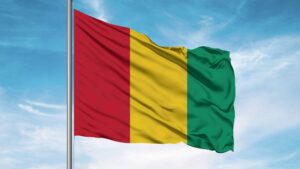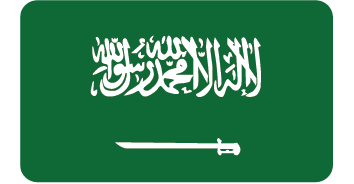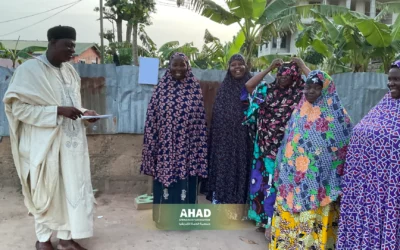Guinea is a country located in West Africa, bordered by the Atlantic sea to the West and Conakry is its capital. Guinea is one of the largest countries on the African continent in terms of area, famous for its picturesque natural diversity, as it includes mountains, valleys, plains and wonderful beaches. Guinea is also the lioness of traditional West African civilization and rich culture. Its rich history dates back to the many powerful empires that reigned in the region before European colonization. Here is the most important information about Location and history of Guinea and the achievements of the AHAD Association in it.
Location and history of Guinea
Guinea is located in West Africa and stretches along the Atlantic Coast. It borders Senegal and Guinea-Bissau to the north, Mali and Ivory Coast to the Northeast, Liberia and Sierra Leone to the South, Equatorial Guinea to the south-southeast. The Niger River is the country’s northeastern border. Guinea has a strategic and distinctive geographical location, as it is located in the region that embraces a rich and diverse nature with a diverse terrain.
History and development of Guinea
The history of Guinea is rich and diverse, spanning thousands of years. The region was home to many ancient civilizations such as the Mali Empire, the SUSU Empire and others. And in the XV century, European explorers explored the west coast of Africa and established the famous slave trade. Under French occupation in the XIX century, Guinea became part of the French colonization of West Africa. It gained its independence in 1958. Since then, Guinea has gone through several political and economic transformations, but it still occupies an important place on the African continent.

Location and history of Guinea
Geography and climate of Guinea
The terrain of Guinea
Guinea is located in West Africa and stretches along the Atlantic Coast. It borders Senegal and Guinea-Bissau to the north, Mali and Ivory Coast to the Northeast, Liberia and Sierra Leone to the South, Equatorial Guinea to the south-southeast. The Niger River is the country’s northeastern border. Guinea has a strategic and distinctive geographical location, as it is located in a rich and diverse natural area with its diverse topography.
The climate in Guinea
Guinea has a humid tropical climate along the coast, with abundant rainfall throughout the year. General temperatures range between 20 degrees Celsius and 30 degrees Celsius. As we move inland, the climate shifts to subtropical, where rains are less and temperatures rise. Guinea is also influenced by the fresh sea winds from the Atlantic Ocean.
These are some information about guinea, explaining the importance of its geographical location, the diversity of terrain and climate in determining its unique nature.
Culture and heritage of Guinea
Language and religion in Guinea
In Guinea, the Fula, the Susu, the Mandinka, the Takruri, the Baga, the Soninke, the Kinzi, the Konika, the Yoruba, the Maninda and the pollarda are among the main peoples who live there. The official language of the country is French, however local languages such as Fula, Susu, Mandinka, Yoruba and manyenda are also widely recognized. In terms of religion, Guinea is diverse, where Islam is the main religion among the population and it is believed that about 85% of the population professes Islam. There is also a set of local religions and Christianity, which is professed by some other residents.
Art and music in Guinea
Guinea is distinguished by its rich and diverse cultural heritage of art and music. Art in Guinea reflects the diversity of different cultures and peoples living in the country. The art of Guinea is characterized by bright colors and complex geometric patterns. Music in Guinea is an integral part of the daily life of the population. Guinean music is distinguished by its enthusiastic rhythms, powerful sounds and local musical instruments that are used to give Spirit and vitality to musical gambles. The artist “Salah Makhlouf” is known worldwide for being one of the most prominent Guinean musicians.
Economy and resources of Guinea
Economic sectors of Guinea
Guinea is one of the largest African countries in terms of economy and resources. The country’s economy consists mainly of the following sectors:
Mining industry: Guinea is famous for its abundance of mineral resources, especially bauxite, which is a major source of aluminum in the world.
Agriculture: agriculture forms an important part of Guinea’s economy, where crops such as rice, cocoa, coffee, peanuts, bananas and cotton are grown.
Manufacturing industries: Guinea is developing the manufacturing sector, such as metal fabrication, oil refining and the manufacture of agricultural products.

Location and history of Guinea
Ahad Association of Guinea
The Ahad Association in Guinea is working on many wonderful and important achievements in the field of child care. The association aims to improve the quality of life of children and ensure their basic rights to health, education and protection.
AHAD focuses on providing medical care to children in need by providing access to basic healthcare and necessary vaccines. The association also works to provide educational support to children and provide learning opportunities and sustainable development through the construction of schools and the provision of educational materials.
In addition, AHAD is keen to protect children from homelessness, violence and exploitation. She works to raise awareness of the local community about children’s rights and issues related to protection and provide psychological and social support to abused children.
The AHAD Association is an honorable model for NGOs in Guinea, offering comprehensive care to children and striving to make their lives happier and safer. The Association deserves appreciation and encouragement for its continuous efforts in serving children and achieving positive change in society.
Natural resources of Guinea
Guinea has rich and diverse natural resources, which contribute to the prosperity of its economy. Some of Guinea’s primary resources include:
Bauxite: Guinea ranks first in the world in the reserves of bauxite, which is the basic raw material for the production of aluminum.
Iron: Guinea has significant iron resources that are used in the steel industry and industrial conversions.
Aluminum: Guinea is a major producer of aluminum in the world, as it has several large factories for the production of aluminum.
By investing these huge resources and developing various economic sectors, Guinea seeks to achieve economic growth and provide employment opportunities for the population.
Tourism in Guinea
Tourist attractions of Guinea
Guinea is an exciting and diverse tourist destination, characterized by the beauty of its picturesque nature and rich culture. Guinea hosts many attractions that are worth visiting, such as:
Mount Nimba: Mount Nimba is the highest peak in West Africa and offers breathtaking views of the picturesque landscape.
Kombo falls: Kombo Falls is one of the most beautiful waterfalls in Guinea, as it is located in the Amazon jungle and is a great destination for nature lovers.
Korobia National Park: korobia National Park provides an opportunity to discover the rich biodiversity of Guinea and see amazing wildlife.
Travel and accommodation in Guinea
When traveling and staying in Guinea, You can enjoy a unique and pleasant experience. The country has world-class hotels and resorts that suit all budgets. You can also enjoy delicious local cuisine in restaurants and cafes throughout the country.
When planning your trip to Guinea, it is advisable to check the visa requirements and follow the local health and security directives. Also you can rent a car to move around the country and enjoy excursions to discover the beauty of Guinea.
Exploring Guinea will give you a unique experience and the opportunity to discover its rich cultural and natural heritage. You will enjoy the wonderful tourist places and interact with friendly locals.
Traditional dishes of Guinea
Cuisines of Guinea
In Guinea, traditional cuisine is an important part of the country’s culture. Guinea is famous for the diversity of its cuisine, serving delicious and unique dishes. Here is some basic information about the cuisine of Guinea:
Soukous: it is a famous dish in Guinea that consists of chicken or beef meat with onions, peppers and local spices. It is served with distinctively cooked white rice.
Razia: Razia is one of the basic dishes in Guinea. It consists of beef or lamb stewed with herbs and spices and served with rice.
Poti: the famous Poti dish in Guinea consists of beef or lamb stewed with onions, peppers and local spices. Served with rice and vegetables.
Fonio: it is a type of cereal used in many traditional dishes in Guinea. Fonio can be used in the preparation of soups and main dishes.
Trying the traditional cuisine of Guinea will give you the opportunity to discover its rich heritage and enjoy unique and mouth-watering flavors. You can try these dishes in traditional restaurants or while visiting the local food markets in Guinea.
National holidays in Guinea
Guinea celebrates many national holidays that reflect its rich heritage and culture. One of the most important holidays is Independence Day, which falls on the twenty-second of September. The Guinean people celebrate this day with national festivals, artistic and cultural performances reflecting the spirit of unity and independence.
Guinea also celebrates May Day on the first of May, and Heroes ‘ Day on the twenty-second of January. These celebrations bring together people across the country to celebrate their achievements and sacrifices in the service of the Fatherland.
Conclusion
Celebrations and festivals are an important part of Guinea’s culture and play a role in promoting unity and bonding between people. Through these celebrations, the Guinean people share joy, fun, exchange congratulations and wishes. Guinea’s heritage is celebrated and its rich values and traditions are promoted on these national occasions.
In short, celebrations and festivals in Guinea are an opportunity for the people to communicate, interact and celebrate their cultural and national heritage. These celebrations reflect the spirit of unity and belonging to the homeland and represent the pride of the Guinean people in their country.
also read:







